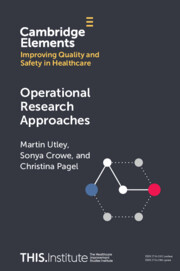References
4.Pidd, M. Tools for Thinking: Modelling in Management Science, 2nd ed. Chichester: John Wiley and Sons; 2002.
5.Komashie, A, Kotiadis, K, Lamé, G, Clarkson, PJ Systems mapping. In: Dixon-Woods, M, Brown, K, Marjanovic, S, et al., editors. Elements of Improving Quality and Safety in Healthcare. Cambridge: Cambridge University Press; forthcoming.
6.Lewis, MA, Vasilakis, C. Operations management approaches. In: Dixon-Woods, M, Brown, K, Marjanovic, S, et al., editors. Elements of Improving Quality and Safety in Healthcare. Cambridge: Cambridge University Press; forthcoming.
7.Radnor, Z, Lean, Williams S. and associated techniques for process improvement. In: Dixon-Woods, M, Brown, K, Marjanovic, S, et al., editors. Elements of Improving Quality and Safety in Healthcare. Cambridge: Cambridge University Press; forthcoming.
8.Clark, GW. Machine-shop engineering roots of Taylorism: the efficiency of machine-tools and machinists, 1865–1884. In: Spender, J-C, Kijne, HJ, editors. Scientific Management: Frederick Winslow Taylor’s Gift to the World? Boston, MA: Springer; 1996: 33–62. https://doi.org/10.1007/978-1-4613-1421-9_2. 9.Crowther, J, Whiddington, R. Science at War. London: HMSO; 1947.
11.Crown, W, Buyukkaramikli, N, Thokala, P, et al. Constrained optimization methods in health services research – an introduction: report 1 of the ISPOR Optimization Methods Emerging Good Practices Task Force. Value Health 2017; 20: 310–9. https://doi.org/10.1016/j.jval.2017.01.013. 13.Soft systems, Checkland P. methodology: a thirty year retrospective. Syst Res Behav Sci 2000; 17: S11–S58. https://doi.org/10.1002/1099-1743(200011)17:1+<::AID-SRES374>3.0.CO;2-O. 14.Checkland, P, Poulter, J. Soft systems methodology. In: Reynolds, M, Holwell, S, editors. Systems Approaches to Managing Change: A Practical Guide. London: Springer; 2010: 191–242. https://doi.org/10.1007/978-1-84882-809-4_5. 15.Augustsson, H, Churruca, K, Braithwaite, J. Re-energising the way we manage change in healthcare: the case for soft systems methodology and its application to evidence-based practice. BMC Health Serv Res 2019; 19: 666. https://doi.org/10.1186/s12913-019-4508-0. 16.Crowe, S, Brown, K, Tregay, J, et al. Combining qualitative and quantitative operational research methods to inform quality improvement in pathways that span multiple settings. BMJ Qual Saf 2017; 26: 641–52. http://dx.doi.org/10.1136/bmjqs-2016-005636. 17.Emes, M, Smith, S, Ward, S, Smith, A. Improving the patient discharge process: implementing actions derived from a soft systems methodology study. Health Syst 2019; 8: 117–33. https://doi.org/10.1080/20476965.2018.1524405. 19.Glaize, A, Duenas, A, Martinelly, CD, Fagnot, I. Healthcare decision-making applications using multicriteria decision analysis: a scoping review. J Multi-Criteria Decis Anal 2019; 26: 62–83. https://doi.org/10.1002/mcda.1659. 21.Dehe, B, Bamford, D. Development, test and comparison of two multiple criteria decision analysis (MCDA) models: a case of healthcare infrastructure location. Expert Syst Appl 2015; 42: 6717–27. https://doi.org/10.1016/j.eswa.2015.04.059. 22.Brazil, V, Purdy, E, Bajaj, K. Simulation as an improvement technique. In: Dixon-Woods, M, Brown, K, Marjanovic, S, et al., editors. Elements of Improving Quality and Safety in Healthcare. Cambridge: Cambridge University Press; forthcoming.
23.Brailsford, SC, Harper, PR, Patel, B, Pitt, M. An analysis of the academic literature on simulation and modelling in health care. J Simul 2009; 3: 130–40. https://doi.org/10.1057/jos.2009.10. 24.Vanderby, SA, Carter, MW, Noseworthy, T, Marshall, DA. Modelling the complete continuum of care using system dynamics: the case of osteoarthritis in Alberta. J Simul 2015; 9: 156–69. https://doi.org/10.1057/jos.2014.43. 25.Cassidy, R, Singh, NS, Schiratti, P-R, et al. Mathematical modelling for health systems research: a systematic review of system dynamics and agent-based models. BMC Health Serv Res 2019; 19: 845. https://doi.org/10.1186/s12913-019-4627-7. 28.Utley, M, Gallivan, S, Pagel, C, Richards, D. Analytical methods for calculating the distribution of the occupancy of each state within a multi-state flow system. IMA J Manag Math 2009; 20: 345–55. https://doi.org/10.1093/imaman/dpn031. 29.Izady, N, Worthington, D. Setting staffing requirements for time dependent queueing networks: the case of accident and emergency departments. Eur J Oper Res 2012; 219: 531–40. https://doi.org/10.1016/j.ejor.2011.10.040. 31.Brailsford, SC, Eldabi, T, Kunc, M, Mustafee, N, Osorio, AF. Hybrid simulation modelling in operational research: a state-of-the-art review. Eur J Oper Res 2019; 278: 721–37. https://doi.org/10.1016/j.ejor.2018.10.025. 32.Viana, J, Brailsford, SC, Harindra, V, Harper, PR. Combining discrete-event simulation and system dynamics in a healthcare setting: a composite model for Chlamydia infection. Eur J Oper Res 2014; 237: 196–206. https://doi.org/10.1016/j.ejor.2014.02.052. 33.Pagel, C, Banks, V, Pope, C, et al. Development, implementation and evaluation of a tool for forecasting short term demand for beds in an intensive care unit. Oper Res Health Care 2017; 15: 19–31. https://doi.org/10.1016/j.orhc.2017.08.003. 43.Craig, P, Dieppe, P, Macintyre, S, et al. Developing and evaluating complex interventions: the new Medical Research Council guidance. BMJ 2008; 337: a1655. https://doi.org/10.1136/bmj.a1655. 49.Bowers, J, Cheyne, H, Mould, G, et al. A multicriteria resource allocation model for the redesign of services following birth. BMC Health Serv Res 2018; 18: 656. https://doi.org/10.1186/s12913-018-3430-1. 50.Cribb, A, Entwistle, V, Mitchell, P. Values and ethics. In: Dixon-Woods, M, Brown, K, Marjanovic, S, et al., editors. Elements of Improving Quality and Safety in Healthcare. Cambridge: Cambridge University Press; forthcoming.
51.Institute of Medicine (US) Committee on Quality of Health Care in America. Crossing the Quality Chasm: A New Health System for the 21st Century. Washington, DC: National Academies Press; 2001. https://doi.org/10.17226/10027. 57.Pearson, M, Monks, T, Gibson, A, et al. Involving patients and the public in healthcare operational research – the challenges and opportunities. Oper Res Health Care 2013; 2: 86–9. https://doi.org/10.1016/j.orhc.2013.09.001. 58.Robert, G, Locock, L, Williams, O, et al. Co-producing and co-designing. In: Dixon-Woods, M, Brown, K, Marjanovic, S, et al., editors. Elements of Improving Quality and Safety in Healthcare. Cambridge: Cambridge University Press; 2022. https://doi.org/10.1017/9781009237024. 61.Vindrola-Padros, C, Eyre, L, Baxter, H, et al. Addressing the challenges of knowledge co-production in quality improvement: learning from the implementation of the researcher-in-residence model. BMJ Qual Saf 2019; 28: 67–73. https://doi.org/10.1136/bmjqs-2017-007127. 63.MASHnet. The UK Network for Modelling & Simulation in Healthcare. https://mashnet.info/ (accessed 23 March 2022). 64.Hulshof, PJH, Kortbeek, N, Boucherie, RJ, Hans, EW, Bakker, PJM. Taxonomic classification of planning decisions in health care: a structured review of the state of the art in OR/MS. Health Syst 2012; 1: 129–75. https://doi.org/10.1057/hs.2012.18. 65.Kirby, MW. Operational Research in War and Peace: The British Experience from the 1930s to 1970. London: Imperial College Press; 2003. https://doi.org/10.1142/p247. 66.Winston, WL, Goldberg, JB. Operations Research: Applications and Algorithms. Belmont, CA: Brooks/Cole – Thomson Learning; 2004.

 Loading metrics...
Loading metrics...


